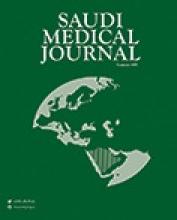Abstract
OBJECTIVE: To evaluate and compare 3 widely used molecular techniques, namely, restriction endonuclease analysis of plasmid deoxyribonucleic acid (REAP), randomly amplified polymorphic DNA (RAPD) and pulsed-field gel electrophoresis (PFGE) for their suitability and usefulness in the typing and fingerprinting of bacterial isolates.
METHODS: Twenty-four epidemiologically unrelated methicillin-resistant Staphylococcus aureus (MRSA) isolates were used to evaluate the molecular typing methods (REAP, RAPD and PFGE). The study was conducted at the Research and Diagnostic Laboratories of King Faisal Specialist Hospital and Research Center from January 2002 through January 2003.
RESULTS: Only 20.8% of all isolates studied were of the same genotypes by all 3 methods. Two major clusters of strains each representing 33% of the total number of isolates were identified by REAP analysis. Each of RAPD and PFGE however, identified one major cluster represented by 54% and 83% of the total number of isolates, All 3 typing methods, therefore, showed the clonal genetic relatedness among distant MRSA isolates. However inter-strain comparison of fingerprint data generated from each method revealed differences in clonal representation of the MRSA isolates.
CONCLUSION: Although a variety of molecular assays are available for typing of bacterial species, there is no single standardized protocol for routine analysis. Reproducibility and interpretation of genotypic data are therefore, highly dependent on methodologies employed by the individual laboratory. Our findings illustrate the importance of using a combination of methods in typing schemes of bacterial isolates. In terms of reproducibility and typeability we found that PFGE is superior to REAP and RAPD and, therefore, more suitable for routine, standardized tracing of nosocomial bacterial isolates.
- Copyright: © Saudi Medical Journal
This is an open-access article distributed under the terms of the Creative Commons Attribution-Noncommercial-Share Alike 3.0 Unported, which permits unrestricted use, distribution, and reproduction in any medium, provided the original work is properly cited.






